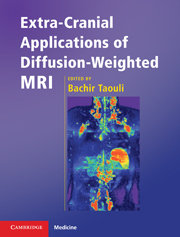Book contents
- Frontmatter
- Contents
- List of contributors
- Preface
- 1 Basic physical principles of body diffusion-weighted MRI
- 2 Diffusion-weighted MRI of the liver
- 3 Diffusion-weighted MRI of diffuse renal disease and kidney transplant
- 4 Diffusion-weighted MRI of focal renal masses
- 5 Diffusion-weighted MRI of the pancreas
- 6 Diffusion-weighted MRI of the prostate
- 7 Breast applications of diffusion-weighted MRI
- 8 Diffusion-weighted MRI of lymph nodes
- 9 Diffusion-weighted MRI of female pelvic tumors
- 10 Diffusion-weighted MRI of the bone marrow and the spine
- 11 Diffusion-weighted MRI of soft tissue tumors
- 12 Evaluation of tumor treatment response with diffusion-weighted MRI
- 13 Diffusion-weighted MRI: future directions
- Index
- References
6 - Diffusion-weighted MRI of the prostate
Published online by Cambridge University Press: 10 November 2010
- Frontmatter
- Contents
- List of contributors
- Preface
- 1 Basic physical principles of body diffusion-weighted MRI
- 2 Diffusion-weighted MRI of the liver
- 3 Diffusion-weighted MRI of diffuse renal disease and kidney transplant
- 4 Diffusion-weighted MRI of focal renal masses
- 5 Diffusion-weighted MRI of the pancreas
- 6 Diffusion-weighted MRI of the prostate
- 7 Breast applications of diffusion-weighted MRI
- 8 Diffusion-weighted MRI of lymph nodes
- 9 Diffusion-weighted MRI of female pelvic tumors
- 10 Diffusion-weighted MRI of the bone marrow and the spine
- 11 Diffusion-weighted MRI of soft tissue tumors
- 12 Evaluation of tumor treatment response with diffusion-weighted MRI
- 13 Diffusion-weighted MRI: future directions
- Index
- References
Summary
Background
Epidemiology
Prostate cancer is the most frequently diagnosed carcinoma in men in the UK. It occurs at an increasing rate with advancing age with most patients being over the age of 60 years at the time of diagnosis. The incidence of detected carcinoma of the prostate has increased dramatically due to new screening and biopsy techniques and varies dramatically with screening levels. In Western Europe, the age-standardized incidence rate is 61.6 per 100 000 compared with 119.9 in North America where screening is widespread; however, there is little variation in the mortality rates of 17.5 per 100 000 in Western Europe and 15.8 per 100 000 in North America. There are also remarkable racial differences in incidence: in the USA the incidence rate is 40% lower in Asians and 50% higher in African Americans than in Whites, and the African American population also have the highest death rates from prostate cancer. About 10% of cases are familial, with a significantly increased risk in men whose first-degree relatives have had the disease. Patients with a BRACA2 mutation have a higher incidence of prostate cancer. However, the vast majority of cases are sporadic.
The cause of prostatic carcinoma is unknown. Because of the distribution in incidence worldwide there is some suggestion but no proof yet that dietary fat may increase the risk of developing prostate adenocarcinoma by influencing levels of testosterone, which in turn affects the growth of the prostate. There is no evidence of a relationship between benign prostatic hyperplasia (BPH) and carcinoma.
- Type
- Chapter
- Information
- Extra-Cranial Applications of Diffusion-Weighted MRI , pp. 72 - 85Publisher: Cambridge University PressPrint publication year: 2010



